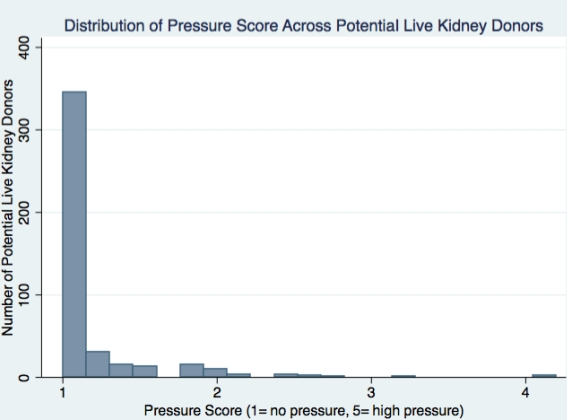A Novel Tool to Evaluate Coercion, Pressure, and Motivation in Potential Live Kidney Donors
A. Shaffer,1 E. King,1 J. Kahn,2 L. Erby,3 D. Segev.1
1Surgery, Johns Hopkins University, Baltimore, MD
2Bergman Institute for Bioethics, Johns Hopkins University, Baltimore, MD
3School of Public Health, Johns Hopkins University, Baltimore, MD.
Meeting: 2015 American Transplant Congress
Abstract number: C146
Keywords: Donors, Informed consent, Kidney transplantation, unrelated
Session Information
Session Name: Poster Session C: Living Donor Issues 2
Session Type: Poster Session
Date: Monday, May 4, 2015
Session Time: 5:30pm-6:30pm
 Presentation Time: 5:30pm-6:30pm
Presentation Time: 5:30pm-6:30pm
Location: Exhibit Hall E
Live donor kidney transplantation yields improved graft survival and recipient longevity, as compared to deceased donors. However, one concern with living donation is the potential risk of coercion or pressure on individuals to donate when approached by a transplant candidate. Currently, there is no widely used, standard test to measure donor pressure in a clinical setting. We use a novel assessment to evaluate pressure experienced by live donor candidates, determine primary motivations for considering donation, and identify demographic factors associated with increased pressure.
Methods:
We modified a psychological questionnaire of perceived coercion to generate a novel pressure assessment for potential kidney donors, composed of six questions. Results of the first five questions (answered on a Likert scale from “Strongly Agree” to “Strongly Disagree,") were averaged to compute a pressure score. The sixth question qualitatively ascertained the candidate's primary motivation for donation. From November 25, 2013, data were prospectively collected on every individual calling our center for live donor evaluation.
Results:
Our study population included 400 potential live donors with a mean age of 41.8 years (SD=13.3). The mean pressure score was 1.1 (SD=0.3) and ranged from 1 to 4.2.  Of the respondents, 79.2% had a total pressure score of 1, indicating that they had experienced no pressure. There was no difference in mean pressure score by age, sex, race, or recipient/donor relationship type. The primary ranked motivation for donation was 86.3% "I wanted to help my recipient."
Of the respondents, 79.2% had a total pressure score of 1, indicating that they had experienced no pressure. There was no difference in mean pressure score by age, sex, race, or recipient/donor relationship type. The primary ranked motivation for donation was 86.3% "I wanted to help my recipient."
[both] Conclusion:
Our data show that most potential kidney donors do not report experiencing pressure, and there is no clearly identifiable demographic profile for those who do experience pressure. This pressure assessment can be used to identify donor candidates facing pressure to donate early in the evaluation process so that these concerns can be fully addressed prior to donation.
To cite this abstract in AMA style:
Shaffer A, King E, Kahn J, Erby L, Segev D. A Novel Tool to Evaluate Coercion, Pressure, and Motivation in Potential Live Kidney Donors [abstract]. Am J Transplant. 2015; 15 (suppl 3). https://atcmeetingabstracts.com/abstract/a-novel-tool-to-evaluate-coercion-pressure-and-motivation-in-potential-live-kidney-donors/. Accessed December 28, 2025.« Back to 2015 American Transplant Congress
